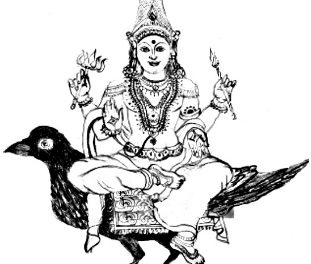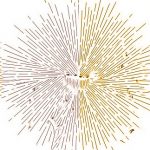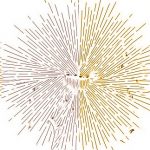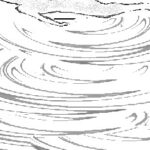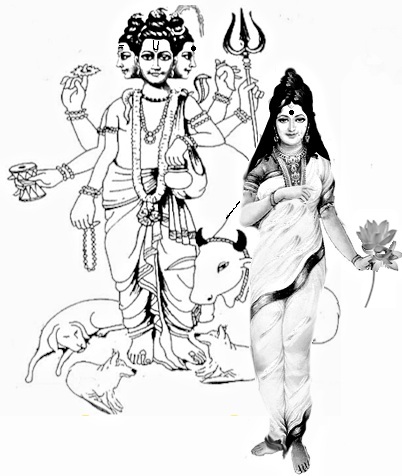
அனகாலஷ்மி தேவி
-சாந்திப்பிரியா —
வேத, புராண வரலாற்று நம்பிக்கைகளின்படி, ஸ்ரீ தத்தாத்ரேயர், 80 மில்லியன் ஆண்டுகளுக்கு முன், த்ரேதா யுகத்தில் அதாவது 10 வது யுக சுழற்சியில் அவதரித்தார் என்பதாக தெரிகின்றது. ஒவ்வொரு கல்ப கால முடிவிலும் அதாவது 4294.08 மில்லியன் மனித ஆண்டுகளைக் கொண்ட ஒரு கல்பத்தின் முடிவில் பிரம்மா உள்ளிட்ட அனைத்து தெய்வங்களும் பரபிரும்மனின் உடலில் ஒன்றிணைந்து மறைந்து விடும் போது, சிவபெருமான் பிரபஞ்சத்தை அழிப்பார். பிரபஞ்சம் அழிக்கப்பட்ட பின்னர், பரபிரும்மன் மீண்டும் பிரும்மாவுடன் இணைந்து புதிய பிரபஞ்சத்தை உருவாக்குகின்றார்.
இதனால் பிரபஞ்சத்தில் எந்த கர்பத்தில் பகவான் ஸ்ரீ தத்தாத்ரேயர் அவதரித்தார் என்று தெரியவில்லை என்றாலும், விஞ்ஞானிகள் கோட்பாட்டின்படி (Big Bang எனும் பெரு வெடிப்பு) தற்போதைய பிரபஞ்சம் 13.7 பில்லியன் ஆண்டுகளுக்கு முன்பாகவே முன்பாகவே தோன்றி இருக்க வேண்டும் என்பது தெரிகின்றது, அதில் காணப்பட்ட சில விலங்கு இனத்தில் இருந்து இரு கால்களில் நடக்கத் துவங்கிய நமது மூதையோர் தோன்றியது சுமார் ஆறு அல்லது ஏழு மில்லியன் வருடங்களுக்கு முற்பட்டது என்று கூறப்படுவதால், முதல் கர்பத்தில் ஸ்ரீ தத்தாத்திரேயரின் அவதாரம் இருந்திருக்க வேண்டும் என்று நாம் கருதலாம்.
தர்ம பாரம்பரியத்தை நிலை நாட்டவும் ஆன்மீக ஞானத்தை வெளிப்படுத்தும் விதமாக ஞான மூர்த்தியாக வெளிப்பட்ட, மும் மூர்த்திகளின் உருவமாகிய பரபிரும்மன் எனும் ஸ்ரீ தத்தாத்ரேயர், தம்மை சிஷ்யர்களாக ஏற்றுக் கொண்டு ஆன்மீக உயர் நிலையை அடைய வழி காட்டுமாறு நாடி வந்தவர்களையும், அத்தனை ஏன், தெய்வங்களையும் கூட ஆன்மீக உயர் நிலை பாதைக்கு அழைத்துச் சென்றவர்.
முதல் கல்ப காலத்தில் ஒரு அவதூத உருவில் வெளியாகி ஞான அருள் புரிந்தவர், கலியுகத்தில் ஸ்ரீ தத்தாத்திரேயர் தனது உண்மையான வடிவத்தை வெளிக் காட்டாமல், அவரது பரம்பரையில் வெளியான ஆன்மீக தெய்வீக மகான்கள் மூலம் அருள் பாலித்து வருகின்றார்.
ஏற்கனவே தெய்வீக சக்திகளை உள்ளடக்கி இருந்த தெய்வங்களுக்கு வேறென்ன ஆன்மீக உயர்நிலை பாதை தேவை என்று ஒருவர் ஆச்சரியப்படலாம். ஆனால் உண்மை நிலை என்ன? தெய்வங்கள் தெய்வீக சக்திகளை உள்ளடக்கியவர்கள் என்பதில் எந்த சந்தேகமும் இல்லை என்றாலும், அவர்களில் சிலர், பல்வேறு காரணங்களினால், பெற்றிருந்த சாபங்கள் மற்றும் தவறுகள் காரணமாக பூமியில் பிறப்பு எடுத்து சாப விமோசனம் பெற வேண்டி இருந்தன. ஆகவே அவர்களுக்கு ஆன்மீக மேல் நிலை பாதை பூமியில் அவசியம் ஆயிற்று. வானுலகிலோ அசுர சக்திகளுடன் நடைபெற்று இருந்த பல்வேறு போர்கள் மற்றும் சில தவறுகள் காரணமாக தெய்வங்கள் அவரவர்களின் தெய்வீக சக்திகளையும் இழக்க நேரிட்டது. அவற்றை திரும்பப் பெற்று மீண்டும் தெய்வீக நிலையை முழுமையாக அடைய அங்கும் மேல் நிலை தெய்வீக போதனை அவசியம் ஆயிற்று. இதில் அடங்கி உள்ள உயர்ந்த தத்துவமும் அதன் ஆழமும் மானிடர்கள் சிந்தனைக்கும் எண்ணங்களுக்கும் அப்பாற்பட்டவை.
கலியின் கோர பிடியில் இருந்து மக்களை காப்பாற்றி ஆன்மீக பாதையில் அழைத்துச் செல்ல வேண்டும் என்பதற்காக பல்லாயிரக்கணக்கான ஆண்டுகள் முன்னர் ஸ்ரீ தத்தாத்திரேயர் ஒரு அவதூதராக அவதரித்து அந்த செயல் முறையை துவக்கினார். அந்த வழி முறையில் செயல்பட தனது சக்தியில் இருந்தே நிழல் வடிவமாக ஒரு பெண் தெய்வத்தையும் படைத்தார். கலியுகத்தில் மக்களை கலியனின் கோரப் பிடியில் இருந்து காப்பாற்றி மக்களை ஆன்மீக பாதையில் கொண்டு செல்ல இரு வழிப் பாதை தேவையாக இருந்தது. அவதூத வடிவில் அதை தொடங்கி வைத்தப் பின், முதல் பாதையில் தெய்வீக மகான்கள் வடிவில் தோன்றி மக்களை நல் வழிப் படுத்தினார். அடுத்த பாதையாக பெண் தெய்வங்களுக்கான விரதங்கள் மற்றும் பூஜை வழி முறைகளை துவக்க வைத்து, அவற்றின் மூலம் அவர்களது சிந்தனை மற்றும் ஆத்மாவையும் ஒன்றிணைக்கும் வழிமுறையை நிலை நாட்டினார். அது சரி இரண்டாம் வழி முறையில் எதற்காக பெண் தெய்வத்திற்கு முக்கியத்துவம் தரப்பட்டது ?
வேத, புராண மற்றும் பிற நூல்களில் உள்ள தத்துவங்களையும், கதைகளையும் நாம் ஆழ்ந்து பார்த்தால், அகண்டம் வெளியான பின்னர் நடைபெற்ற பல நிகழ்வுகளிலும் பெண் தெய்வங்களே மூல மையங்களாக இருந்து ஆக்ரோஷமான வெளிப்பாடு, லீலைகள் போன்றவற்றை வெளிக்காட்டி உள்ளார்கள். நடைபெற்ற யுத்தங்கள் அசுரர்களை அழிக்கும் போர்கள், தீமைகளை அழிக்க நடைபெற்ற போர்கள் மற்றும் பிற தெய்வீக லீலைகள் என எதுவாக இருந்தாலும் சரி, அவை அனைத்திலுமே பெண் தெய்வங்களின் பங்கே முக்கியமானதாக இருந்துள்ளது. யுத்தங்களில் பங்கேற்றவர்களில் பெருமளவு பெண் தெய்வங்கள் மூலம் வெளியான துணை பெண் தெய்வங்களும் அடங்கும். அத்தனை ஏன், ஆண் பெண் சக்திகளை, உருவமற்ற தன்னுள் அடக்கி வைத்து இருந்ததாக கூறப்படும் பரபிரும்மனை கூட பெண்ணினத்தைக் குறிக்கும் பராசக்தி என்றே வேதங்களும் புராணங்களும் குறிப்பிட்டு உள்ளன. அதனால்தான் விரத வழிபாடுகள், பண்டிகைகள் என எதுவாக இருந்தாலும் பெரும்பாலானவை பெண் தெய்வங்களை சுற்றியே அமைந்து வந்துள்ளன. இந்த நிலையை வலுப்படுத்தவே பரபிரும்மன் எனப்படும் ஸ்ரீ தத்தாத்திரேயர் தன்னுள் இருந்து ஒரு பெண் தெய்வத்தை வெளிக் கொண்டு வந்தார். அதனால் தான் அவதூதராக இருந்தாலும், தனது யோக சக்தியில் இருந்து ஒரு பெண் தெய்வமான அனகா தேவியை வெளிப்படுத்தி தெய்வங்களில் ஆண் மற்றும் பெண் என்ற பேதங்கள் எதுவுமே கிடையாது, அனைத்து தெய்வங்களும் ஒருவரே, தெய்வங்கள் வெவ்வேறு தோற்றங்களில் காணப்பட்டாலும், அவற்றின் அவதாரங்களுக்கு ஏற்ப தனித் தனி சக்திகள் கொண்டவைகளாக இருந்தாலும், ஒரே மூல தெய்வத்தின், அதாவது ஆண் பெண் சக்திகளை உள்ளடக்கிக் கொண்டிருந்த பரபிரும்மனின் உள் இருந்தே வெளியான மாய பிம்பங்களேயாகும் என்ற மிகப் பெரிய தத்துவத்தை புரிய வைத்தார்.
அனகாலஷ்மி தேவி தோற்றம்
இந்த தத்துவத்தை வெளிப்படுத்தும் விதமாக பெண் தெய்வமான அனகா தேவியின் தோற்றம் நிகழ்வுற்றது என்பதினால் அவரது தோற்றம் குறித்து கூறப்படும் கதை தனித் தன்மை வாய்ந்தது. ஸ்ரீ தத்த புராணத்தின்படி, பல நூறு வருடங்கள் தவத்தில் இருந்திருந்த முனிவர்கள் ஒரு பெரிய நீர் நிலையின் அருகில் இருந்த ஸ்ரீ தத்தாத்திரேயரை ஒரு இளம் அவதூத வடிவத்தில் கண்டபோது, அவருடைய மேன்மை மற்றும் மகத்துவத்தை உடனடியாக புரிந்து கொண்டு அவரிடம் சென்று ஞான மார்க்கத்தின் உயர் நிலைக்கு தம்மை அழைத்துச் செல்லுமாறு வேண்டிக் கொண்டார்கள். முனிவர்கள் அனைவரும் ஒன்று சேர்ந்து தம்மிடம் வந்ததைக் கண்ட ஸ்ரீ தத்தாத்ரேயர் அவர்களை உடனடியாக சீடராக ஏற்றுக் கொள்ள முன் வராமல், அவர்களது மன உறுதியை சோதிக்க விரும்பினார்.
ஆகவே அவர்களுக்கு போதனைகள் செய்து கொண்டு இருந்தபோதே திடீர் என அந்த பெரிய நீர் நிலையில் குதித்து நீரில் மூழ்கி மறைந்து விட்டார். நீர் நிலையில் விழுந்த ஸ்ரீ தத்தாத்ரேயர் திடீரென காணாமல் போனதைக் கண்டு அதிர்ச்சியடைந்த சில முனிவர்கள் அவர் வெளியே வருவதற்காகக் காத்திருக்காமல் அங்கிருந்து கிளம்பிச் சென்று விட்டார்கள். ஆனால் பல முனிவர்கள் ஸ்ரீ தத்தாத்திரேயர் நீர் நிலையில் இருந்து வெளி வருவார் என்ற நம்பிக்கையுடன் குளத்தின் கரையில் காத்திருந்தனர். அவர் எப்போது வேண்டுமானாலும் தோன்றுவார் என்று எதிர்பார்த்து காத்திருந்த நிலையில், நூறு ஆண்டுகளுக்கும் மேலாக தண்ணீரில் மூழ்கிக் கிடந்தபடியே முழுமையான சமாதி நிலையில் இருந்தார் ஸ்ரீ தத்தாத்ரேயர்.
அந்த சகாப்தத்தில் நூற்றுக்கணக்கான ஆண்டுகள் காத்திருப்பது பெரிய விஷயமே இல்லை. ஏன் எனில் அங்கிருந்த பல முனிவர்கள் கூட பல நூற்றுக்கணக்கான ஆண்டுகள் தவத்தில் இருந்துள்ளவர்கள். உதாரணமாக அத்ரி முனிவர் தனக்கு ஒரு குழந்தை வேண்டும் என்பதற்காக ஆயிரம் ஆண்டுகளுக்கும் மேலாக தவம் இருந்தார் என்பது இதற்கு ஒரு உதாரணம் ஆகும்.
ஆனாலும் குளத்திலிருந்து வெளியே வருவதற்கு முன் மீண்டும் தனக்காக காத்திருந்த முனிவர்களை சோதிக்கும் விதமாக குளத்தின் உள் இருந்து முதலில் அழகிய இளம் மங்கையை வெளி வரச் செய்தார். அப்படி வெளிப்பட்ட அழகிய பெண் உண்மையில் ஸ்ரீ தத்தாத்திரேயரின் தெய்வீக மற்றும் யோக வலிமையினால் வெளியான தெய்வம் என்ற ரகசியத்தை அறிந்திடாத முனிவர்கள் அவள் யார், தெய்வமா இல்லை வேறு பெண்ணா என்று விடை தெரியாமல் திக்கிட்டு நின்றிருந்தபோது, குளத்தில் இருந்து வெளி வந்த அந்த அழகான பெண் அற்புதமான நடனம் புரிந்தவாறு அமிர்தம் நிரம்பிய குடத்தை ஏந்தியபடி வந்தாள்.
அவர்கள் மனம் குழம்பி நின்றிருக்க, ஸ்ரீ தத்தாத்திரேயரின் அருள் கிடைக்க காத்திருந்த முனிவர்களின் மன திடனை சோதிக்க, அந்த பெண்ணோ தனது கையில் இருந்த குடத்தில் இருந்து மதுவை குடித்தபடி நடனம் ஆடுவதை போல ஒரு நாடகத்தை நடத்தினாள். தேவியின் இளமைத் தோற்றம் குறித்த உண்மையை அறிந்திடாத சில முனிவர்கள் அவள் குடித்தது மது என்று நினைத்து அவளுக்கு ‘மதுமதி’ (மது அருந்தியவள்) என்று பெயரிட்டனர். வேறு சிலர் அவரது நடனம் வெள்ள நதியின் அசைவுகளை ஒத்திருந்ததால் அவளை ‘நாடி’ என்று அழைத்தனர். அவளை மதுமதி மற்றும் நாடி என்றும் தவறாக அழைத்தவர்கள் இறைவனின் லீலையை காணத் தவறி அவளை பாவம் செய்த பெண்ணாகப் பார்த்தார்கள்.
இருப்பினும், அறிவாற்றல் மிக்க முனிவர்கள் அந்தப் பெண் அருந்தியது மது அல்ல, இது போன்ற நாடகங்கள் அனைத்தும் ஸ்ரீ தத்தாத்ரேயரின் தெய்வீக லீலைகளே, தமது மன திடனை சோதிக்கவே அவர் அப்படி ஒரு நாடகம் நடத்துகின்றார் என்று நம்பினர். ஆனால் அவர்களில் இன்னும் சிலர் அவள் ஸ்ரீ தத்தாத்திரேயரை காண விடாமல் தமது கவனத்தை திசை திருப்புகின்றாள் என்று எண்ணிக் கொண்டு சென்று விட்டார்கள். அந்தப் பெண் ஸ்ரீ தத்தாத்திரேயரின் யோக ஆற்றலில் இருந்து வெளி வந்த பெண் தெய்வமே என்பதை உணர்ந்தவர்கள் அவளை ஸ்ரீ தத்தாத்ரேயாவின் பெண் வடிவமாக போற்றி, துதித்து, வழிபட்டபடி இருந்தார்கள். ஸ்ரீ தத்தாத்ரேயர் மும் மூர்த்திகளின் (பிரம்மா, விஷ்ணு, மற்றும் மகேஸ்வர்) அவதாரம் என்பதினால், அவரது பெண் சக்தி மூலம் வெளியான பெண் தெய்வமும் மும் மூர்த்திகளின் (சரஸ்வதி, லட்சுமி மற்றும் பார்வதி) சக்திகளை உள்ளடக்கியவர் என்றே நம்பினார்கள்.
அங்கிருந்த ஒவ்வொருவரின் உள் மனமும் அங்கு தோன்றிய பெண்ணின் அம்சங்கள் மற்றும் பண்புகளைப் குறித்து பல்வேறு எண்ணங்களுடன் அலைந்து கொண்டு இருக்கையில், சமாதி நிலையை துறந்து விட்டு குளத்தின் உள் இருந்து வெளி வந்த ஸ்ரீ தத்தாத்திரேயர் அங்கு பெண் வடிவில் இருந்தவள் தனது யோக சக்தியில் இருந்து வெளியான தூய்மையான மற்றும் பாவமற்ற பெண் தெய்வமான அனகா தேவி என்று கூறிய பின்னர் அவளே தன்னுடைய பெண் ஆற்றல் கொண்ட தன்னுடைய துணைவி என்றும் கூறினார்.
தெய்வங்களில் ஆண் மற்றும் பெண் என்ற வித்தியாசங்கள் கிடையாது. பல அம்சங்களையும் வெளியில் காட்டும் விதமாக, ஆண், பெண் மற்றும் இருபாலின தோற்றங்களில் காட்சி தரும் அனைத்து தெய்வங்களும் ஒரே தெய்வத்தின் மாய பிம்பங்களே என்பதை அனைவருக்கும் உணர்த்தும் விதமாக இந்த லீலையை நடத்திக் காட்டினார். அந்த தத்துவத்தை முழுமையாக உணர்ந்தவர்களால் மட்டுமே ஸ்ரீ தத்தாத்திரேயர் மார்கத்தில் செல்ல முடியும் என்பதையும் உணர்த்தினார்.
இறைவன் அவளுக்கு அனகா என்ற பெயரை ஏன் கொடுத்தார்? அனகா என்ற சொல் துன்பங்களை நீக்குபவர் என்பதைக் குறிக்கும். அகா என்பது துன்பத்திற்கான காரணங்களைக் குறிக்கும் சொல் ஆகும். அகாவின் நிலை என்ன என்றால் வறுமை, நோய், எதிரிகளின் மீதான பயம், பேராசை மற்றும் அறியாமை என பல வழிகளிலும் துன்பத்தைத் தருவதாகும். அதே சமயம் செழிப்பு, ஆரோக்கியம், பாசம், மனநிறைவு, ஞானம் போன்றவற்றை வழங்கி அனைத்து துன்பங்களையும் அழிக்கும் நிலையை பிரதிபலிப்பதே அனகா என்பது ஆகும். அதனால்தான் ஸ்ரீ தத்தாத்திரேயர் மூலம் வெளியான அந்த பெண் தெய்வத்திற்கு அனகா தேவி என்ற பெயரை ஸ்ரீ தத்தாத்திரேயர் சூட்டினார்.
தேவி அனகா எனும் பெண் தெய்வம் ஸ்ரீ தத்தாத்திரேயருடைய யோக சக்தி மூலம் வெளிப்பட்டதினால்தான் ஸ்ரீ தத்தாத்திரேயரைப் போலவே பெண் துறவியாக காணப்பட்டார். அவள் அனகா தேவியாக தோன்றியதால், பல்வேறு ரூபங்களை பல நிலைகளில் எடுத்து இருந்த, ஸ்ரீ தத்தாத்திரேயரும் தன்னை அனகா தேவா எனும் அவதாரமாக மாற்றிக் கொண்டார். ஸ்ரீ தத்தாத்திரேயர் இதுவரை பதினாறு ரூபங்களில் அவதரித்து உள்ளார் என்பதாக கூறுகின்றார்கள். தாய் பாசத்தை வெளிப்படுத்தவே அனகா தேவியை படைத்தார். அனகா தேவியை வணங்கித் துதித்தவர்கள் வாழ்வில் செழிப்பும் மன அமைதியும் கிடைக்கப் பெற்றனர். அவர்களின் துயரங்கள் அனைத்தும் மறைந்து விட்டன. சில முனிவர்கள் நினைத்தது போல அவள் பாவம் செய்தவள் இல்லை, ஆனால் மக்களின் பாவங்களையும் துயரங்களையும் நீக்க வந்தவள் ஆகும்.
பெண் தெய்வமான அனகாலஷ்மி தேவி ஸ்ரீ தத்தாத்ரேயரின் யோக சக்தி மூலம் வெளி வந்ததினால், பிரகாசமான முகத்துடன், மணிகளால் பின்னப்பட்ட கணுக்கால் கொலுசு எனப்படும் நகை அணிந்து, ஒரு காலை இன்னொரு காலின் தொடை மீது வைத்தபடியும், தாமரை மலர் மீது அமர்ந்துள்ள நிலையிலும் மிக அழகான பெண்ணாக சித்தரிக்கப்பட்டாள். அவள் ஒரு கையில் தாமரையை ஏந்திக்கொண்டு இன்னொரு கையில் அபய முத்திரையைக் காட்டியபடி இருக்கின்றாள். ஸ்ரீ தத்தாத்திரேயர் போலவே, கண்களை பாதி மூடிய நிலையில் யோக நிலையில் உள்ளாள். சம காலத்தில் ஒரே நேரத்தில் இரு தோற்றங்களும் – அனகா தேவி மற்றும் அனகா தேவா தோன்றியதால் இரு அவதாரங்களையும் வேறுபடுத்திப் பார்க்க முடியாது. சில நேரங்களில் அனகா தேவி மூன்றாவது கண், சடை முடி, கழுத்தில் ருத்திராட்சம், தளி முடி மீது கங்கை மற்றும் சந்திரன் போன்ற அம்சங்களைக் கொண்டும் காட்சி தருவதின் மூலம் தானும் சிவபெருமானின் அம்சமே என்பதை வெளிப்படுத்துகின்றார். நான்கு கைகளிலும் காணப்படுவது அபய முத்திரை, சக்கரம், திரிசூலம் மற்றும் சங்கு ஆகும். அவளது காலுக்கு கீழே தெய்வீக நந்தி காணப்படும். மகரிஷி வியாசரால் தொகுக்கப்பட்ட பவிஷ்யோத்தர புராணத்தின் ஒரு பகுதியான தத்த புராணத்தில் அனகா தேவி, மற்றும் அனகா தேவரின் மேன்மையைக் குறிப்பிடும் விதத்தில் ஒரு கதை காணப்படுகிறது. தெலுங்கு பிராந்தியங்களின் சில பகுதிகளில், அந்த கதை சற்றே மாறுபட்டு நாடோடி கதைகளின் வடிவத்தில் சொல்லப்படுகிறது. அசுரர்களின் கொடுங்கோன்மையிலிருந்து தேவர்கள் காப்பாற்றப்பட்டு ஜம்பா என்ற அசுரன் எவ்வாறு கொல்லப்பட்டார் என்ற கதை வேறுபடுகிறது. ஸ்ரீ தத்தாத்திரேயரை விஷ்ணுவின் அம்சம் என்று பலர் நம்புவதால், அனகா தேவியை செல்வம், அதிர்ஷ்டம் மற்றும் செழிப்பு போன்றவற்றை தரும் லட்சுமி தேவியின் அம்சமாகக் கருதினர். அதனால்தானோ என்னவோ ஸ்ரீ லட்சுமி தேவியின் புகழைக் கூறும் இரண்டு மிக முக்கியமான ஸ்லோகங்களில் அனகா தேவியின் பெயரும் உள்ளது.
‘அஷ்டோத்திர சதநாமாவளி’ ஸ்லோகத்தில்
அனகா தேவியின் மேன்மை
லட்சுமி தேவியை போற்றி கூறப்படும் ‘அஷ்டோத்திர சதநாமாவளி’ என்பதில் 32 வது வரியில் – ‘அனகா – ஓம் அனஹாயை நமஹா’ என்றும் லலிதா சஹஸ்ரநாமத்தின் 108 வது ஸ்லோகத்தில் கீழ்கண்டவாறும் கூறப்பட்டு உள்ளது.
யோனி முத்ரா த்ரை கன்டேஷி த்ரிகுண அம்பா த்ரை கோனகா
அனகா அத்புத சரித்திர வஞ்சிஹித் – அர்த்த ப்ரதாயினீ
மேற்கண்ட ஸ்லோகத்தின் விளக்கம் :
யோனி முத்ரா – யோனி முத்திரையில் காணப்படுபவள்
த்ரை கன்டேஷி – பத்து முத்திரைகளில் ஒன்றான த்ரைக்கண்டா எனும் முத்திரையைக் கொண்டவள்
த்ரிகுண – சத்வ, ரஜஸ் மற்றும் தமஸ் குணத்தைக் கொண்டவள்
அம்பா – இந்த லோகத்திற்கெல்லாம் தாயானவள், அனைவருக்கும் தாயானவள்
த்ரை கோனகா – முக்கோணத்தில் வசிப்பவள்
அனகா – பாவங்கள் அற்றவள்
அத்புத சரித்திர- அவளது செயல்கள் அற்புதமானவை
வஞ்சிஹித் – அர்த்த ப்ரதாயினீ – அவளே வேண்டுவது அனைத்தையும் தருபவள்
அனகா தேவியின் மேன்மை – புராணக் கதை
அனகா தேவியை குறித்த புராணக் கதை இது. ஒருமுறை ஜம்பா என்ற அரக்கன் தலைமையில் அசுரர்களுக்கும் தேவர்களுக்கும் பெரும் சண்டை நடந்தது. வானுலகத்தில் இருந்த தேவ படைக்கு இந்திரன் தலைமை தாங்கினார். பல ஆண்டுகளாக நீடித்த கடுமையான போரில், ஜம்பாவின் அசுரப் படைகளால் தேவ சக்திகளின் படை முழுமையாக தோற்கடிக்கப்பட்டன. அதனால் இந்திரன் தனது ராஜ்யத்தை விட்டு ஓட வேண்டியிருந்தது. முனிவர்களின் ஆலோசனையின் பேரில், இந்திரன் தேவர்கள் படைகளுடன் சஹயாத்ரி மலைக்குச் சென்று ஸ்ரீ தத்தாத்ரேயரிடம் தஞ்சம் அடைந்தார். இந்திரன் படைகளைத் துரத்திக் கொண்டு வந்த அசுரன் ஜம்பாவின் படைகள், ஓடிக் கொண்டு இருந்த தேவர்கள் மீது அம்பு எய்தும், பல ஆயுதங்கள், கனமான பாறைகள், தீப பறக்கும் ஆயுதங்கள் மற்றும் இரும்புக் கம்பிகளைக் கொண்டு தாக்கியும் கொன்றார்கள். மேலும் ஜம்பாவின் படைகள் எருதுகள், எருமைகள், புலிகள், குரங்குகள், கழுதைகள் போன்ற பல வாகனங்களில் ஏறி அவர்களை துரத்த அந்த மிருகங்களும் தேவர்களை தாக்க அதில் பல தேவர்கள் மரணம் அடைந்தார்கள். இறுதியாக அசுரன் ஜம்பா தலைமையிலான படையினரும் சஹயாத்ரி மலையை சென்று அடைந்தன. அங்கு ஸ்ரீ தத்தாத்ரேயரின் குடில் இருந்தது.
தேவர்கள் ஸ்ரீ தத்தாத்ரேயரிடம் சென்று சரணடைந்தபோது, அனகா தத்தா தனது மனைவி அனகா தேவியுடன் அமர்ந்திருந்தார். அவர் தேவர்களுக்கு ஆறுதல் கூறி தனது ஆதரவையும் தந்தார். அவர்களை அமைதிப்படுத்தினார். அசுரன் ஜம்பாவுடன் வந்த படைகள் அனகா தேவியைக் கண்டதும், அவள் தெய்வம் என்பதை அறியாமல், அவர்களின் பிறவிக் குணமான பிசாசு குணம் மற்றும் காமத்தால் அவளது அழகில் மயங்கி அவளுக்கு பூங்கொத்து கொடுக்க ஓடினார்கள். ஜம்பாவின் படைகளைக் கண்ட ஸ்ரீ தத்தாத்திரேயர் அனகா தேவியைப் பார்த்து ஒரு விஷமத்தனமான சிரிப்பு சிரித்தபடி சில சமிக்கைகளைக் காட்டினார். அப்படி செய்த பின்னர் அசுரப் படையினரை கண் கொட்டாமல் பார்த்தார். அந்த யோகப் பார்வையில் அவர்களது மன பலம் மட்டும் அல்ல, அவர்களது வீரமும், போர் பலமும் முற்றிலும் அழிந்தது. அவ்வளவுதான் அடுத்த கணம் அனகா தேவி அந்த சேனையினருடைய தலை மீது ஏறிக்கொண்டு நடனம் ஆடத் துவங்கினாள். அவள் ஆடிய நடனத்தினால் வலி தாங்க முடியாமல், ஜம்பாவின் படைகள் வேதனையில் கதறி துடிக்கத் துவங்க, தேவர்களின் படையினர் விரைவாகச் சென்று அவர்களை கொன்றார்கள். இந்திரனும் ஜம்பாவைக் கொன்றார். இப்படியாக தேவர்கள் ஸ்ரீ தத்தாத்திரேயர் அனுகிரகத்தினால் தாம் இழந்த ராஜ்யத்தை மீட்டுக் கொண்டார்கள்.
அனகா தேவியின் மேன்மை- நாட்டுப்புற கதை
அனகா தேவி மேன்மை குறித்த மற்றொரு நாட்டுப்புற கதை உள்ளது. ஒருமுறை ஜம்பாசுரன் எனும் அசுரன் தேவ லோகத்தின் மீது படையெடுக்க அந்த யுத்தம் பல ஆண்டுகள் நீடித்தது. அதில் தோற்றுப் போன இந்திரன் தனது தேவ குருவான பிரஹஸ்பதியுடன் அடுத்து என்ன செய்யலாம் என ஆலோசனை செய்தபோது அவர் கூறினார் ‘ஜம்பாசுரன் பெற்று இருந்த வரத்தின் காரணமாக அவனை மும் மூர்த்திகளினால் கூட தமது தனிப்பட்ட சக்திகளினால் அழிக்க முடியாது. அந்த மூன்று சக்திகளும் ஒன்றிணைந்தால் மட்டுமே இந்திரனை காப்பாற்ற முடியும் என்றும், அந்த மும்மூர்த்திகளின் அவதாரம் ஸ்ரீ தத்தாத்ரேயரின் உருவில் உள்ளதினால் அவரை நாடுமாறு அறிவுரை கொடுத்தார். மேலும் அவரது அருளை எளிதில் பெற முடியாது. ஏன் எனில் அவர் பல லீலைகளை நடத்தி வந்தவர்களின் மன உறுதியை சோதனை செய்த பின்னரே தம்மை அண்ட விடுவார் என்று கூறி அனுப்பினார். இந்திரனும் ஸ்ரீ தத்தாத்திரேயரை காண அவரது குடிலுக்கு சென்று அவரை சந்தித்தார். ஆனால் எப்போதும்போல பல நாடகங்களை நடத்திய பின்னரே ஸ்ரீ தத்தாத்திரேயர் இந்திரன் முன் தோன்றினார். இந்திரன் தம்மால் வானுலக தேவர்களை ஜம்பாசுரனின் கொடுமையில் இருந்து காப்பாற்ற முடியாத தர்ம சங்கட நிலையைக் கூறி அவனை வதம் செய்ய அவருடைய அருள் தேவை எனக் கூறி விட்டு அவரிடம் சரணடைந்தார். இதற்கிடையில், இந்திரனை துரத்திக் கொண்டு அங்கு வந்த ஜம்பாசுரன் தன்னை சந்திக்காமல் முதலில் அனகா தேவியை சந்திக்கும் வகையில் ஸ்ரீ தத்தாத்திரேயர் ஏற்பாடு செய்து இருந்தார். அதற்கேற்ப அந்த அசுரனும் அங்கு வந்த பின் முதலில் அனகா தேவியை சந்திக்க நேரிட்டது. பார்த்த உடனேயே அந்த தேவியின் அற்புத அழகில் மயங்கிய அசுரன் நேரடியாகவே அனகா தேவியிடம் சென்று தான் அவளை மணக்க விரும்புவதாக கூறினான். அதைக் கேட்ட அனகா தேவியும் தான் அவனது தலையில் ஏறி நடனம் ஆட அவன் சம்மதித்தால் மட்டுமே அவனை மணப்பதாக கூறினாள். அதை செய்வது அவனுக்கு கடினமான காரியம் இல்லை. தனது தலையை மிகப் பெரியதாக்கிக் கொண்டு அதன் மீது நடனம் ஆட வைக்க முடியும் என்பதினால் அவளை தன் தலை மீது அமர வைக்க முயற்சி செய்தான். ஆனால் அதற்கு முன்னரே ஸ்ரீ தத்தாத்திரேயரோ அவனது பலம் முழுவதையும் தனது யோக சக்தியால் எடுத்து விட்டார். ஆகவே அவன் எத்தனை முயன்றாலும் எளிதில் அனகா தேவியை தனது தலையில் வைத்துக் கொள்ள முடியாமல் திணறி விட்டு, எப்படியோ அவளை தன் தலை மீது ஏற்றி வைத்துக் கொள்ள, அடுத்த கணமே அவன் எரிந்து சாம்பலானான். அவன் பெற்று இருந்த வரத்தின்படி, அவனது அழிவிற்கான நேரம் வரும்போது மட்டுமே அவனால் தன் தலை மீது யாரையும் ஏற்றி வைக்க முடியும். மேலும் ஆண் பெண் சக்திகள் ஒன்றிணைந்த தெய்வத்தால் மட்டுமே அவனை கொல்ல முடியும் என்பதும் அவனுக்கு கிடைத்து இருந்த வரம் ஆகும் என்பதினால்தான் அனகா தேவி மூலம் அவன் மரணம் அடைந்தான். ஆணவமும் தலை கனமும் அளவிற்கு மேல் போனால் அழிவு நிச்சயம் என்ற தத்துவமே அனகா தேவியின் இந்த தெய்வ லீலை மூலம் வெளியாயிற்று.
அவதூத வடிவில் இருந்த ஸ்ரீ தத்தாத்ரேயர் அனகா தேவியின் மகிமையையும் அவளைக் குறித்த விரதத்தையும் கார்த்தவீரியனுக்கு எடுத்துரைத்தார். அனகா விரதம் செய்வதின் மூலம் ஒருவருடைய பாவங்கள் விலகும், திருமணத் தடைகள் விலகும், தம்பதியர் ஒற்றுமை வலிமைப்படும். ஸ்ரீ தத்தாத்திரேயர் கார்த்தவீரியனுக்கு கூறிய அனகா தேவியின் வழிபாட்டை ‘அனகா விரதம்’ என்ற பெயரில் பரப்பிய முதல் அரச மன்னன் கார்த்தவீரியன் என்றாலும், திரேதா யுகத்தில் ஸ்ரீ தசரதன் மற்றும் ஸ்ரீ ராமர் இந்த வழிபாட்டை மேற் கொண்டனர். துவாபர யுகத்தில் பகவான் ஸ்ரீ கிருஷ்ணர் அந்த விரதத்தை செய்யுமாறு எம தர்ம ராஜாவுக்கு அறிவுறுத்தினார். இந்த விரதத்தை அனுசரிக்கும் பல கிராமங்களில், இரவு முழுவதும் பக்தி இசை மற்றும் நடனத்துடன் விரதத்தின் மேன்மை கூறப்பட்டு மறுநாள் விடியற் காலையில் விரதம் துவக்கப்பட்டு பூஜை செய்யப்படுகிறது. வழக்கமாக அனகாஷ்டமி (அனகாலஷ்மி) விரதத்தை மார்கசிர மாதத்தின் (டிசம்பர்) பதினைந்தாவது நாளில் கிருஷ்ண பக்ஷ அஷ்டமி அன்று செய்யலாம்.

Goddess Anagha Devi
Santhipriya
As per Vedic and mythological beliefs, Lord Dattatreya manifested 80 million years ago* in Treta Yuga which began 2.16 million years ago and lasted thereafter for 1,296,000 human years, the 10th in Yuga cycle.
A Kalpa, i.e a period of 4.32 billion human years is one day (and an equal length of night) of Lord Brahma. At the end of one Kalpa, Lord Brahma along with entire fleet of divines and all living entities in the universe enter into the body of Parabrahman and merge with him, a state called non-manifestation or sleep within the Supreme Being who is non but Parabrahman himself. After the dissolution of the universe thus, Parabrahman again brings out a new cosmos when Lord Brahma again recreates everything afresh.
As per the scientific theory called ‘Big Bang’, the present universe which we see today appeared 13.7 billion years ago. The sight of species walking with two legs, meaning first antecedents of humans appeared only before six to seven million years; therefore, Lord Dattatreya, the embodiment of Trimurtis, may have also manifested during such yuga to uphold the traditions of dharma as Gnanamurti, the personification of spiritual wisdom.
Ever since he manifested, he appeared both visible and invisible, to guide and impart wisdom to both the divines and human race toward spiritual advancement. In Tretha Yuga, Lord Dattatreya appeared in the form of an Avadhoot to bestow wisdom to the seekers, however, in Kali Yuga, he guided the seekers only through the spiritual masters who were his incarnates.
It may surprise what kind of spiritual guidance the divines with divine powers may need. It is true that the divines manifest with divine powers beyond our contemplation, but when some of the divines took birth on earth in physical form, to perform penance to redeem some of the curses incurred by them on several occasions in celestial spaces, they do need guidance to perform specific deeds, or to achieve a certain level of understanding to break the curse as they will be sans of divine powers while in physical form as human.
The philosophy behind this is beyond the contemplation of humans to understand. Some philosophical stances maintain that the fundamental nature of the universe or the existence of a higher power is fundamentally unknowable or unprovable to humans.
In order to save the mankind from suffering in Kali Yuga, several thousands of years ago, not only Lord Dattathreya manifested in the form of a wandering Avadhoot, but also, he created a shadow emanation in the form of a female Goddess called Anagha Devi to assist him in some manner. He realized that he has to act suitably to guide the folks to escape the wrath of Kali Yuga (Age of Darkness) when there will be decline in dharma (righteousness), morality, physical strength, and lifespan. Therefore, the act of spiritual guidance to escape the fury of Kali needed to be applied twin fold i.e gender-specific mode; spiritual guidance for men, and penances/poojas for women.
While Lord Dattathreya decided that he will impart spiritual guidance to the male part in many ways and means to tread the spiritual path, the female needed to be guided to perform penances, vrath and poojas to gain ability to merge thoughts with inner soul which will ultimately strengthen the spiritual path.
It is not difficult to understand why the female deities have been given prominence in many acts of divine. If one read the texts of Vedas, Puranas and other scriptures, they will see numerous instances of female deities displaying active and aggressive powers to uphold cosmic order; they were involved in intense battles fought against demons, asuras, evil forces to aid the male divines either directly or indirectly.
Most of the vrath and poojas performed center around female deities, who are revered as various emanations of the divine feminine energy known as Parashakti. This energy is considered an essential and dynamic aspect of the Supreme Being called Parabrahman, which is actually a union of male and female energies within which Lord Dattathreya too stand.
Lord Dattatreya, in his guise as a male Avadhoot, manifested his female energy as Goddess Anagha Devi to reveal to the universe that male and female deities are not separate, but ultimately one and the same from Parabrahman. His act of emanating Goddess Anagha Devi demonstrated that outward appearances, including gender of the divines are merely illusions, though each one of them appeared as if they were individual power centers either for creation or destruction for reasons of their own.
Manifestation of Anagha Devi
Goddess Anagha Devi’s manifestation stand testimony to the philosophy of Lord Dattathreya who wanted both male and female combination to mould folks to tread the path of spirituality during Kaliyuga. The manifestation of Goddess Anaha is quite interesting.
According to Datta Purana, once several sages and Maharishis who were in penance on the banks of a river, one day spotted Lord Dattatreya in the form of a wandering Avadhoot at a far-off distance on the banks of a pond. Since many had heard lots of stories on him, instantly realizing his greatness, they rushed to him, offered their respect and sought his guidance on the ways and means to attain Gnana marga called wisdom from the whole of creation.
Lord Dattatreya taught the path to Gnana marga (wisdom) by explaining that the entire universe is a teacher and that valuable spiritual lessons can be learned from observing every aspect of creation. He famously cited twenty-four specific entities in nature and life as his gurus. Who those twenty-four specific entities in nature are can be read in detail in Dattathreya Charithra.
One may find in Datta Purana, and narratives in Datta sampradaya traditions that Lord Dattathreya never accepted anyone as his disciple unless their mental agility to withstand the hardship of the penance and sincerity to accept him as their master is tested rigorously.
In such background, when they collectively went to him and aired their desire, Lord Dattathreya, desirous to test them before accepting as his disciple, suddenly jumped into the water body and disappeared. He remained submerged inside the pond for several hundred years. Shocked at his sudden disappearance, few of the sages who came there went away after waiting for some time feeling they will waste time for his re appearance soon, but few other sages, steadfast in their mind to get his guidance, continued to wait on the banks of the pond expecting his reappearance anytime, but Lord Dattatreya remained in a state of complete Samadhi inside the pond for several hundred years.
The very long periods of waiting stretching to even several thousand years is not a big news for many saints and sages who have penanced over several thousands of years, example being sage Athri who penanced for over thousand years to beget an offspring.
After several hundred years, before emerging out of the pond, Lord Dattathreya came out in the most controversial form to further test the remaining sages and saints. First a beautiful looking celestial woman appeared from inside the pond, potentially displaying classic form of dancing and holding pitcher full of wine which are traditionally associated with the material world rather than austere asceticism. Unaware that the beautiful lady who appeared from the pond was none but an aspect of divine play orchestrated by Lord Dattatreya, the sages and saints stood in stoic silence in unbelievable shock. Unknown of Devi’s youthful origin, some of the waiting sages called her Madhumati (seeing her drinking wine), while some called her Nathi (seeing her dance like a river), still some realized her true form (as Lord Dattatreya’s creation) as a female Goddess and worshipped her as female Dattatreya.
The matured sages were convinced that similar to Lord Dattatreya (Anagha Deva) being the combined incarnation of Tridev (Brahma, Vishnu, and Maheshwar), so would Anagha Devi be the embodiment of Three devis, consorts of Trimurtis (Goddesses Saraswathi, Lakshmi, and Parvati). They were sure that she is a motherly creation who will bestow motherly affection to her devotees and Anagha Devi is the sakthi of Lord Dattatreya as she resides within him.
While the inner mind of everyone wavered around with several thoughts on the aspects and attributes of the female emerged, Lord Dattatreya came out of the state of samadhi, appeared before the sages and declared that the female was none other than Goddess Anagha Devi created from his own yogic energy. He named the yogic energy as Anagha (one who was pure and sinless) and declared her to be his consort who is inherent part of him. Thus, the divine couple appeared in the form of Anagha Deva and Anagha Devi before the saints and sages.
He explained to the waiting sages and Maharishis that the reason behind this leela or divine play was to make them aware that there was none like ‘He’ or ‘She’ in divine and all were one, which was ‘He’ alone. The almighty is both formless and in several forms. Lord Dattathreya wanted the disciples to understand that God cannot be classified as male and female. He is also she and she is also he. Whatever the appearances are, the original form of Shakti/energy is beyond the gender differentiation and one might not even find out in which aspects or in what form the Shakti is present in the universe. Only those who were conscious of the philosophy that divines in multi appearances and multi genders- male, female or neuter gender were creations of the same energy, would be able to enter into the path of him i.e Lord Dattatreya.
Why did Lord Dattathreya give her the name Anagha? While mere Agha meant causes of suffering, the word Anagha referred to the remover of the sufferings. The state of Agha is poverty, disease, and fear of enemies, greed, and ignorance which lead to suffering in many ways, while the one who removed all sufferings by bestowing prosperity, health, affection, contentment, wisdom, etc was called Anagha. Hence Anagha Devi represented destroyer of sufferings by bestowing prosperity. Goddess Anagha Devi appeared as a female ascetic since she emerged from the divine energies of Lord Dattatreya who was an Avadhoot.
As she appeared in the form of Anagha Devi, a female ascetic, the Lord too turned himself as Anagha Deva, her divine partner. Lord Dattatreya had many manifestations in different forms and appearances. It is stated that Lord Dattatreya has incarnated in 16 different forms.
Since Anagha Devi was born out of the yogic energy of Lord Dattatreya, she was portrayed as a very beautiful woman with a bright face, eyes partly closed like Lord Datta. She was seen seated in a lotus position wearing an anklet embroidered with bells. She carried a lotus in one hand while the other hand displayed abhaya mudra which is the sign of protection. Sometimes Anagha Devi was seen with all the aspects of Lord Shiva like-third eye, braided hair, rudraksha on the neck, Ganges flowing down from the braided hair and moon on other side of the head. Divine vehicle of Lord Shiva Nandi was was also seen seated below her leg. Since many believe that Lord Dattatreya was aspect of Lord Vishnu, they considered Goddess Anagha Devi to be aspect of Goddess Lakshmi.
The story glorifying Goddess Anagha Devi and Anagha Deva is found in Datta Purana, a part of Bhavishyottara Purana, compiled by Maharishi Vyasa. In some areas of the Telugu regions, a slightly deviated form of the same story is told in the form of nomadic tale. They vary a bit between them on how a Asura called Jamba was killed by the Devi to save the celestials from his tyranny. Beyond those stories no other details are available on Anagha Devi except the mention of her name in slokas and hymns composed on Goddess Lakshmi. Since Lord Dattatreya is considered to be the incarnate of Lord Vishnu, Goddess Anagha Devi represents his consort Lakshmi bestower of prosperity, wealth and fortune. Hence the name of Anagha appear in two most important slokas in worship of Goddess Lakshmi.
Goddess Anagha Devi in Ashthothra Namavalis
There are 108 names of Goddess Lakshmi, which are collectively known as Ashthothra Namavalis. In the 32nd line of Lakshmi Ashthothra it is mentioned as:-
Anagha – Om Anaghayai namaha
The 180th sloka in the Lalitha Sahasranama has the following sloka :-
Yoni mudra tri Khandeshi triguna amba tri konaga.
Anagha adbhuta charitra vajnchihit-artha pradayini
Yoni Mudra – She Who Is In The Form Of The Yoni Mudra
Tri Khandeshi – She Who Is The Ruler Of The Tenth Mudra, The Trikhanda
Triguna – She Who Is Endowed With The Three Gunas Of Sattva, Rajas And Tamas
Amba – She Who Is Mother Of All Beings; Mother Of The Universe
Tri Konaga – She Who Resides In The Triangle
Anagha – She Who Is Sinless
Adbhuta Charitra – She Whose Deeds Are Marvelous
Vajnchihit-artha Pradayini – She Who Gives All The Desired Objects
Story of Lord Anagha Deva and Anaha Devi in Bhavishyottara Purana
A story associated with the Anagha Vrath (ritual), mentioned in Datta Purana, a part of the Bhavishyottara Purana, tells us the greatness of Goddess Anaha Devi. Once a long-drawn battle ensued between the celestial forces and the Asuras led by a Demon King called Jamba. The celestials were led by Lord Indira. In the fiercely fought battle which lasted for many years, the celestial forces faced defeat at the hands of the Asuric forces of Jamba; Lord Indira ran away deserting his Kingdom. However, when he sought asylum to the sages in the jungle, at the suggestion of them, Lord Indira along with celestial forces went to Sahyadri mountain and surrendered at the feet of Lord Dattatreya seeking protection. Jamba riding on several asuric vehicles like oxen, buffaloes, tigers, monkeys, donkeys etc chasing the forces of Lord Indira, attacked them from many sides, and killed lots of celestial forces by firing arrows, throwing clubs, heavy rocks, fire arms and Iron rods etc, besides injuring many. Finally, the forces headed by Jamba chasing the celestials reached the Sahyadri mountain where the hermitage of Lord Dattatreya was located.
When the remaining forces of celestial went and surrendered to Lord Dattatreya, he was in the form of Anagha Deva and his consort Anagha Devi seated by his side, both in the form of ascetics. The Anagha divine couple assured their support to them and calmed them down.
The moment the Asuric forces with Jamba saw Goddess Anagha Devi, they were enchanted by her beauty and, unaware of her divinity due to their devilish nature and lust, they rushed towards her with impure intentions. Lord Anagha gave a gracious, discreet gesture at Goddess Anagha Devi and staired at the faces of the Asuric forces thereby emitting powerful Yogic energies which silently destroyed their strength and power to fight and weakened them completely.
When Lord Anaha Deva’s gesture and yogic gaze destroyed the enemies’ strength, immediately, Goddess Anagha climbed on to the head of the demons and began to dance. Unable to bear the pain by her dancing, as the Demonic forces cried in agony, the celestial forces attacked them quickly and destroyed every one of them. Lord Indira too attacked Jamba and killed him. Thus, the kingdom of heaven was restored to the celestials who experienced the protective power of Lord Dattatreya in the form of Anagha Deva.
Folklore on Lord Anagha Deva and Anaha Devi
One other story is found in folk lore. Once an Asura named Jambasura attacked Deva Loga and the war lasted for several years; at the end of the battle, Jambasura drove away Lord Indira who in turn approached his Deva guru Brahaspathy seeking help. Deva Guru revealed that due to a powerful boon carried by Jambasura, even the Trimurtis cannot defeat Jambasura with their individual powers; only the embodiment of Trinities in the form of Lord Dattatreya would be able to kill him.
Lord Indira immediately rushed to the ashram of Lord Dattatreya which was in Sahyadri mountain. The Deva Guru Brahaspathy hinted that he would not get the grace of Lord Dattathreya easily unless he tests them severally; as advised by Brahaspathy, Lord Indra went and met Lord Dattatreya seeking his support to defeat Jambasura. Lord Dattathreya tested Lord Indira in many ways and when finally found his determination of surrender at his feet, he appeared before him in the form of Anaha Deva to help him defeat the asura. In the mean while Jambasura who was chasing Lord Indira too came to Lord Dattatreya’s hermitage. In order to finish him, Lord Dattatreya ensured that Jambasura met his consort Anagha Devi first, who was standing in an extremely beautiful form.
As soon as Jambasura met Goddess Anagha Devi who appeared as a beautiful woman, forgetting the purpose for which he came and without knowing who she was, he rushed to her and expressed his desire to marry her. The Devi agreed to marry him with a condition that he should allow her to dance over his head. Since Jambasura was gigantic asura with huge head, it was not difficult for the asura to allow her to dance over his head; in the mean while Lord Dattatreya completely weakened the strength of Jambasura without the asura know of it. When Anaha Devi asked Jambasura to lift her and place her over his head, Jambasura was surprised to find that he could not lift the Devi to keep her over his head for dancing; as he struggled to keep her over his head, the time trickled and finally when the destined time for his end came, he could easily lift and place her over his head. Once she stood over his head with his full consent, Jambasura was completely crushed under Devi’s feet allowing Lord Indira regain his kingdom; hence, it is said that destruction is certain for those whose arrogance and pride goes overhead.
‘Anagha Vrath’ in various periods of time
In the form of an Avadhoot, Lord Dattatreya narrated the glory of Goddess Anagha Devi to Karthaveeryan and also guided him the manner in which a Vrath has to be performed for Anagha Devi to get the sins washed off; worship of Anagha Devi by her vrath remove all obstacles in marriage proposals, she will bestow grace for good harmony to the married couple all of which ultimately leads to the mental peace and prosperity.
While Karthaveeryan was the first Royal King to propagate the worship of Goddess Anagha in the name of ‘Anagha Vrath’, King Dasaratha and Lord Rama performed this worship in the Treta Yuga. In Dwapara Yuga, Lord Sri Krishna advised Lord Dharma Raja to perform the vrath and propagate it to his folks.
In many of the Villages where the Vrath is observed, the performance of the Vrath is done with devotional music and dance throughout the night and the next day morning the Pooja is performed to conclude the Vrath.
Usually, the Anaghashtami Vrath is performed on Krishna Paksha Ashtami the eighth day of the dark fortnight of the month of Margasira (December), eighth day of the dark fortnight of the month of Margasira (December).
-Ended-


